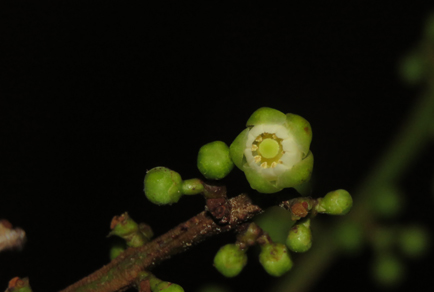Abstract
Carapa cedrotagua, a new species from the surroundings of Serranía de los Yariguíes, in the Eastern Andes of Colombia, is described and illustrated. Notes about its geographical distribution, phenology, uses, conservation status and taxonomic affinities are provided. The new species is similar to C. alticola, C. guianensis, and C. pariensis, but differs from these species mainly by its morphological combination of shorter petiolules 3.4–6(–7) mm long, leaflets secondary veins flat in the abaxial surface, stipitate and beaked fruits with valves bearing warty excrescences, and the spheroid or slightly compressed seeds with hilum 8.2–12.1 × 4.5–6.1 mm. Carapa cedrotagua is a common and economically important species in the area where it occurs, and it is commonly confused with C. guianensis.
References
- Aublet, J.B.C.F. (1775) Plantes de la Guiane Françoise, dont on n’a pu se procurer des es complets. In: Aublet, J.B.C.F. (Ed.) Histoire des Plantes de la Guiane Françoise 2. Pierre-Francois Didot jeune, London & Paris, supplement pp. 1–160.
- Bernal, R. (2016a) Carapa. In: Bernal, R., Gradstein, S.R. & Celis, M. (Eds.) Catálogo de plantas y líquenes de Colombia. Instituto de Ciencias Naturales, Universidad Nacional de Colombia, Bogotá, pp. 1664–1665.
- Bernal, R. (2016b) Geografía de Colombia. In: Bernal, R., Gradstein, S.R. & Celis, M. (Eds.) Catálogo de plantas y líquenes de Colombia. Instituto de Ciencias Naturales, Universidad Nacional de Colombia, Bogotá, pp. 19–32.
- Brown, P. (1756) The Civil and Natural History of Jamaica, in Three Parts. Printed for the author, London, 503 pp.
- Candolle, A.C.P. (1878) Meliacées. In: Candolle, A.L.P.P. de & Candolle, A.C.P. de (Eds.) Monographiae phanerogamarum prodromi nunc continuation nunc revisio, Vol. 1. G. Masson, Paris, pp. 399–758.
- Candolle, A.P. de (1824) Prodromus Systematis Naturalis Regni Vegetabilis, Vol 1. Treuttel & Würtz, Paris, 745 pp.
- Céspedes-Prada, C., Solano-Gutiérrez, C., Duarte-Sánchez, I. & Cogollo-Calderón, A.M. (2020) Restauración ecológica de la zona Norte del Parque Nacional Natural Serranía de los Yariguíes. Unión Temporal Jaguar Corredor Norandino y Parques Nacionales Naturales de Colombia. Bogotá, 130 pp.
- Dauby, G. (2019) ConR: Computation of Parameters Used in Preliminary Assessment Conservation Status. R package version 1.2.4. Available from: https://CRAN.R-project.org/package=ConR (accessed 10 July 2020)
- Ellis, B., Daly, D.C., Hickey, L.J., Johnson, K.R., Mitchell, J.D., Wilf, P. & Wing, S.L. (2009) Manual of Leaf Architecture. 1st ed. Cornell University Press, Ithaca, New York, 190 pp. https://doi.org/10.1079/9781845935849.0000
- Fischer, E., Killmann, D., Leh, B. & Janssens, S.B. (2021) Carapa wohllebenii (Meliaceae), a new tree species from montane forests in the Democratic Republic of Congo, Rwanda, and Burundi. Phytotaxa 511 (1): 20–36. https://doi.org/10.11646/phytotaxa.511.1.2
- Forget, P.-M., Poncy, O., Thomas, R.S., Hammond, D.S. & Kenfack, D. (2009) A new species of Carapa (Meliaceae) from Central Guyana. Brittonia 61: 366–374. https://doi.org/10.1007/s12228-009-9090-z
- Gentry, A.H. (1988) New species and a new combination for plants from trans-andean South America. Annals of the Missouri Botanical Garden 75: 1429–1439. https://doi.org/10.2307/2399294
- IUCN. (2012) IUCN Red List Categories and Criteria: Version 3.1. Second edition. IUCN Species Survival Commission. IUCN, Gland, Switzerland and Cambridge, England, 32 pp.
- IUCN. (2022) The IUCN Red List of Threatened Species. Version 2022-1. [https://www.iucnredlist.org]
- Kenfack, D. (2008) Systematics and evolution of Carapa (Meliaceae—Swietenioideae). Ph.D. Thesis, University of Missouri, St. Louis. 237 pp.
- Kenfack, D. (2011a) A synoptic revision of Carapa (Meliaceae). Harvard Papers in Botany 16: 171–231. https://doi.org/10.3100/0.25.016.0201
- Kenfack, D. (2011b) Resurrection in Carapa (Meliaceae): a reassessment of morphological variation and species boundaries using multivariate methods in a phylogenetic context. Botanical Journal of the Linnean Society 165: 186–221. https://doi.org/10.1111/j.1095-8339.2010.01104.x
- Kenfack, D. (2011c) Carapa vasquezii (Meliaceae), a new species from western Amazonia. Brittonia 63: 7–10. https://doi.org/10.1007/s12228-010-9163-z
- Kenfack, D. & Pérez, Á.J. (2011) Two new species of Carapa (Meliaceae) from Western Ecuador. Systematic Botany 36: 124–128. https://doi.org/10.1600/036364411X553207
- Kottek, M., Grieser, J., Beck, C., Rudolf, B. & Rubel, F. (2006) World map of the Köppen Geiger climate classification updated. Meteorologische Zeitschrif 15: 259–263. https://doi.org/10.1127/0941-2948/2006/0130
- Mabberley, D.J. (2011) Meliaceae. In: Kubitzki, K. (Ed.) The Families and Genera of Vascular Plants X. Flowering Plants: Eudicots, Sapindales, Cucurbitales, Myrtaceae. Springer, Berlin, pp. 185–211. https://doi.org/10.1007/978-3-642-14397-7_13
- Miquel, F.A.W. (1851) Stirpes Surinamensis Selectae. Natuurkundige Verhandelingen van de Hollandsche Maatschappij der Wetenschappen te Haarlem 7 (2): 1–234, supplement [1]–165.
- Moreno, H. & Tinjacá, Z. (2018) Plan de Manejo del Parque Nacional Natural Serranía de los Yariguíes 2018-2023. Territorial Andes Nororientales, Parques Nacionales Naturales de Colombia, Simacota, 152 pp.
- Muellner, A.N., Pennington, T.D. & Chase M.W. (2009) Molecular phylogenetics of Neotropical Cedreleae (mahogany family, Meliaceae) based on nuclear and plastid DNA sequences reveal multiple origins of “Cedrela odorata”. Molecular Phylogenetics and Evolution 52: 461–469. https://doi.org/10.1016/j.ympev.2009.03.025
- Muellner, A.N., Samuel, R., Johnson, S.A., Cheek, M., Pennington, T.D. & Chase M.W. (2003) Molecular phylogenetics of Meliaceae (Sapindales) based on nuclear and plastid DNA sequences. American Journal of Botany 90: 471–480. https://doi.org/10.3732/ajb.90.3.471
- Muellner A.N., Savolainen, V., Samuel, R. & Chase M.W. (2006) The mahogany family “out-of-Africa”: divergence time estimation, global biogeographic patterns inferred from plastid rbcL DNA sequences, extant, and fossil distribution of diversity. Molecular Phylogenetics and Evolution 40: 236–250. https://doi.org/10.1016/j.ympev.2006.03.001
- Palacios, W. (2012) Cuatro especies nuevas de árboles del Ecuador. Caldasia 34: 75–85.
- Ruiz, H. & Pavón, J. (1798) Systema vegetabilium Florae Peruvianae et Chilensis, characteres prodromi genericos differentiales, specierum omnium differentias, durationem, loca natalia, tempus florendi, nomina vernacula, vires et usus nonnullis illustrationibus interspersis complectens. Typis Gabrielis de Sancha, Madrid, 456 pp. https://doi.org/10.5962/bhl.title.887
- Styles, B. (1981) Swietenioideae. In: Pennington, T.D., Styles, B.T. & Taylor, D.A.H. (Eds.) Flora Neotropica Monograph No 28: Meliaceae. The New York Botanical Garden, New York, pp. 359–418.
- Thiers, B. (2016 onward) Index herbariorum: a global directory of public herbaria and associated staff. New York Botanical Garden’s Virtual Herbarium. The New York Botanical Garden, Bronx, New York. Available from: http://sweetgum.nybg.org/science/ih/ (accessed 2 March 2022)
- Thorne, R.F. & Reveal, J.L. (2007) An updated classification of the class Magnoliopsida (“Angiospermae”). The Botanical Review 73: 67–181. https://doi.org/10.1663/0006-8101(2007)73[67:AUCOTC]2.0.CO;2


